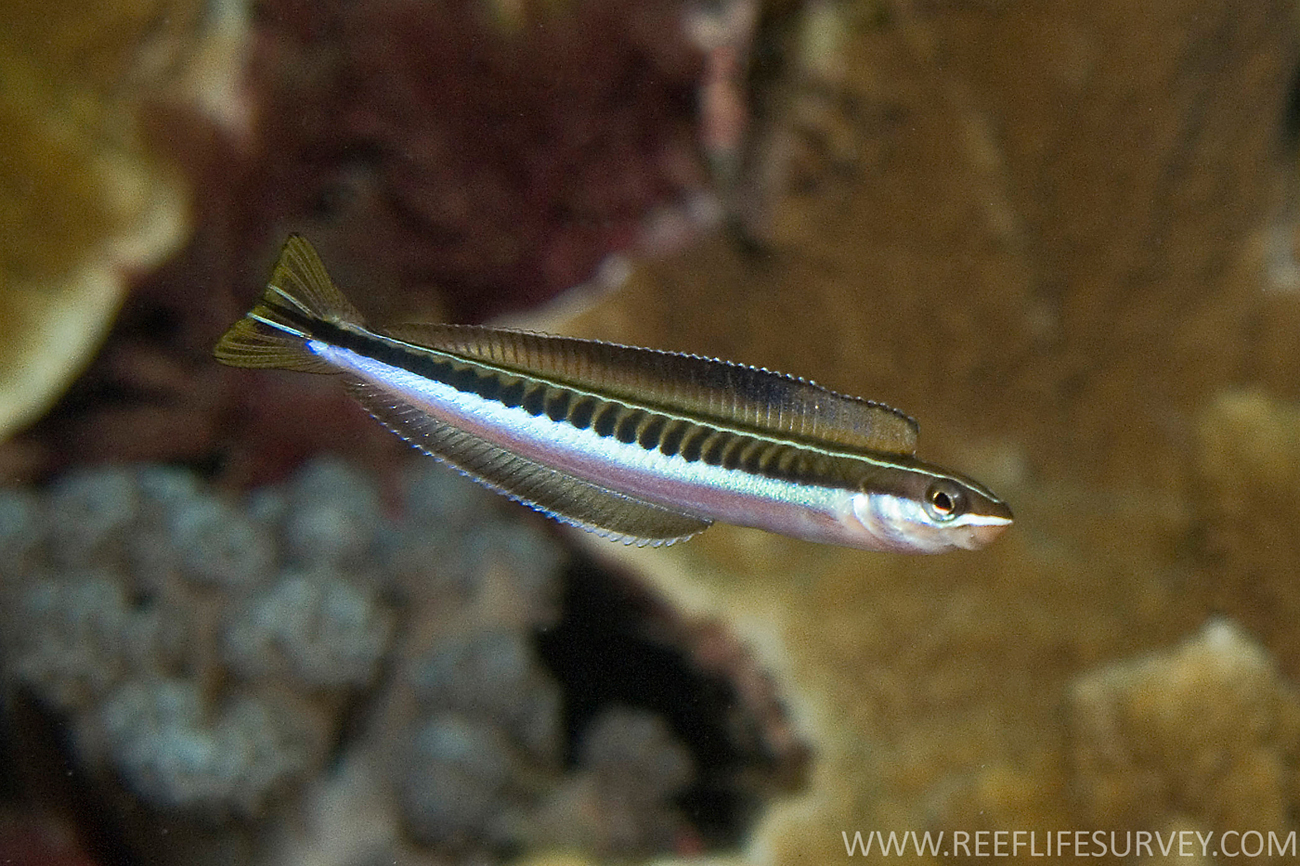- Classification
- ACTINOPTERYGII
- PERCIFORMES
- BLENNIIDAE
- Plagiotremus
- tapeinosoma
Piano Fangblenny, Plagiotremus tapeinosoma (Bleeker 1857)

A Piano Fangblenny, Plagiotremus tapeinosoma, at Little Slope, Lord Howe Island in the Tasman Sea. Source: Andrew J. Green / Reef Life Survey. License: CC BY Attribution
A long, slender sabre-toothed blenny easily recognised by the black wavy stripe comprised of short oblong bars along the midside.
Fangblennies, or sabretooth blennies, are parasitic on other fishes. They have a pair of large canine teeth in the lower jaw, and attack by sneaking up from behind and biting off small pieces of skin, mucous and scales.
These inquisitive fishes are often seen by divers at Lord Howe Island. When alarmed, they dive into in holes and crevices on the reef.
Piano Fangblenny, Plagiotremus tapeinosoma (Bleeker 1857)
More Info
|
Distribution |
Known in Australian waters from Cape York to the Sydney region on the east coast, and from Ashmore Reef to Cockburn Sound on the west coast - also at Elizabeth and Middleton Reefs, and Lord Howe Island. Elsewhere, widespread in the Indo-West-Central Pacific. Piano Fangblennies inhabit coral and rocky reefs in depths of 1-30 m. |
|
Features |
Dorsal fin VII-IX, 34-39; Anal fin II, 28-33. The distinctive dark mid-lateral body stripe is comprised of a series of oblong bars. |
|
Size |
To 14 cm in length |
|
Feeding |
Carnivores. Fangblennies have a pair of large fangs in the lower jaw and feed by attacking other fishes to remove skin, mucous and sometimes scales. They strike rapidly from behind, then dive back into the reef to avoid being punished by the victim. Although harmless, Piano Fangblennies are known to occasionally 'attack' divers. |
|
Biology |
Piano Fangblennies are oviparous (egg layers), and females produce demersal eggs that adhere to the substrate. |
|
Remarks |
Plagiotremus species are aggressive mimics of other fishes. Russell et al. (1976) observed piano fangblennies swimming amongst schools of Thalassoma amblycephalus, Trachinops taeniatus and a tripterygiid of the genus Forsterygion. |
|
Species Citation |
Petroskirtes tapeinosoma Bleeker 1857, Acta Soc. Sci. Indo-Neerlandicae 2: 64. Type locality: Ambon, Indonesia |
|
Author |
Rebecca D. Bray & Dianne J. Bray |
Piano Fangblenny, Plagiotremus tapeinosoma (Bleeker 1857)
References
Allen, G.R. 1997. Marine Fishes of Tropical Australia and South-east Asia. Western Australian Museum. Pp. 292.
Allen, G.R. & R.C. Steene. 1988. Fishes of Christmas Island Indian Ocean. Christmas Island Natural History Association, Christmas Island, Indian Ocean, 6798, Australia. 197 p.
Allen, G.R. & W.F. Smith-Vaniz. 1994. Fishes of the Cocos (Keeling) Islands. Atoll Res. Bull. 412: 21 p.
Bleeker, P. 1857. Achtste bijdrage tot de kennis der vischfauna van Amboina. Acta Societatis Scientiarum Indo-Neerlandicae 2: 1-102 [64].
Francis, M.P. 1993. Checklist of the coastal fishes of Lord Howe, Norfolk, and Kermadec Islands, Southwest Pacific Ocean. Pac. Sci. 47(2): 136-170.
Hoese, D.F., Bray, D.J., Paxton, J.R. & G.R. Allen. 2006. Fishes. In Beesley, P.L. & A. Wells. (eds) Zoological Catalogue of Australia. Volume 35. ABRS & CSIRO Publishing: Australia. parts 1-3, pages 1-2178.
Hutchins, B. & R. Swainston. 1986. Sea Fishes of Southern Australia. Complete Field Guide for Anglers and Divers. Swainston Publishing. Pp. 180.
Johnson, J.W. 1999. Annotated checklist of the fishes of Moreton Bay, Queensland, Australia. Memoirs of the Queensland Museum 43(2): 709-762.
Kuiter, R.H. 2000. Coastal Fishes of South-eastern Australia. Gary Allen. Pp. 437.
Ogilby, J.D. 1896. Descriptions of two new genera and species of Australian fishes. Proceedings of the Linnean Society of New South Wales 21(2): 136-142 [Description of Macrurrhynchus maroubrae, a junior synonym of Plagiotremus tapeinosoma 137, pl. 10(1)].
Randall, J.E. 2005. A review of mimicry in marine fishes. Zoological Studies 44(3): 299-328.
Randall, J.E., Allen, G.R. & R.C. Steene. 1997. Fishes of the Great Barrier Reef and Coral Sea. Crawford House Press. Pp. 557.
Russell, B.C., G.R. Allen & H.R. Lubbock. 1976. New cases of mimicry in marine fishes. J. Zool. (Lond.) 180: 407-423.









